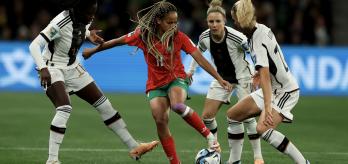Former FIFA Women's World Cup™ winners Germany started their tournament with an impressive 6-0 win over Morocco at the Melbourne Rectangular Stadium. Germany's performance was a fusion of collective chemistry and individual brilliance, all of which translated into devastating attacking output. Grainger explains below how the structure of their build-up and multifaceted attacking plan caused Morocco all sorts of problems, and how their effective counter-press helped them produce one of the best performances of the competition so far.
Key insights
-
Possession-based teams face two connected challenges. First, they have to figure out how to break down an organised defence. Second, they have to do this at the same time as preventing the opposition from inflicting damage on counter-attacks. An effective counter-pressing strategy can help overcome both challenges.
-
A team's ability to counter-press depends on their structure in possession. If they can string together patterns of short passes in the central areas of the pitch, it is likely that their players will already be well-positioned for a counter-press the moment they lose the ball. This is because the team will be concentrated in a small area of the field where the ball has been lost.
- Counter-pressing can serve different objectives. On the one hand, it can allow a team to regain possession and bring the ball back to safer areas of the pitch, giving them time to reset. On the other, it can also help them to win back possession in advanced areas of the pitch and create goal-scoring opportunities.
Line-ups
Germany's game plan
Although the scoreline might suggest otherwise, Germany faced a well organised Morocco team. Out of possession, the Atlas Lionesses set up in a 4-4-2 mid-block with the aim of hurting Germany on the counter. This posed Germany with their biggest challenge of the match: finding ways to break down Morocco's mid-block while protecting themselves from counter-attacks.
As Grainger noted, Morocco's defensive structure was a test for Germany. To meet it "Germany wanted to control the speed of the game through deliberate and patient ball retention, utilising short passing patterns in central areas." Grainger noted. Once they established that control, Germany strove to get their wide players on the ball in 1v1 situations.
Germany's determination to link up in central areas is illustrated by the fact that German players made a total of 131 offers in-between the Moroccan team shape in the middle third. This figure was higher than in any other performance by any side across the whole of the 2019 World Cup and the 2023 World Cup so far, and equates to a highly impressive 3.2 offers for every minute their team was in possession. Germany did not reap any direct rewards in the first half, but their persistence ultimately paid off, as Grainger stressed after the game. "I think the offers [for the ball] tired Morocco out", she said. "They were in great shape in the first half, but the fact that they had to keep making runs forwards and backwards [to match Germany's offers] was tiring."
Germany were relentless in attack, and their ability to recover lost balls quickly helped them to sustain their attacks over prolonged periods. "Their whole possession strategy interlinked with their counter-pressing strategy," explains Grainger. "Because of their build-up structure, they're connected enough [when they lose the ball] to be that aggressive." The structure was not the only thing that impressed Grainger: "It's also their mentality and their attitude to get back behind the ball; their midfielders' attitude to do that was fantastic throughout the game," she observed. This combination allowed them to protect themselves from Morocco's threat on the counter, wear down the opposition by maintaining a fast tempo, and create chances by turning over possession in dangerous areas of the pitch.
Germany's game plan in numbers
Principles of Germany's possession game
As mentioned above, Germany's main challenge was to break down Morocco's defence whilst cutting out counter-attacks. Clip 1 at the end of this section is a prime example of how they rose to this challenge, illustrating both Germany's attacking strategy, which was based on sharp passing patterns and rotation, and their use of the counter-press to halt Morocco's counter-attacks as early as possible. The next part of the article breaks down key moments in the clip.
Structured build-up
In possession, Germany would set up in a 4-2-3-1 (see Image 1). However, over the course of their deep build-up phase, Germany were repeatedly able to switch to a back three comprising left-back Felicitas Rauch (17), left centre-back Sara Doorsoun (23) and right centre-back Kathrin Hendrich (3) (compare Image 2). These three players remained narrow, giving them a strong platform to play short, quick passes. To help them circulate the ball without losing possession, central midfielders Melanie Leupolz (18) and Sara Däbritz (13) operated as two Number 6s (i.e., as a double pivot), consistently forming a "box" with the two centre-backs when building up play.
Rotate on the right, switch to the left
Germany looked to use well-worked rotations and switches of play in order to set up their attacking players in dangerous areas of the pitch (Image 2). One of their main rotations was down the right-hand side of the field, where right-winger Jule Brand (22) would initiate the sequence by inverting into the inside-right channel. On this cue, right full-back Svenja Huth (9) would adopt a position higher up the wing. Number 10 Lina Magull (20) would then drop into the space vacated by her defender, adopting a "false full-back" role. As Grainger explained:
"Here Magull would get on the ball – but not necessarily to play passes forward [so much as to] really create, connect and lend passes as part of the build-up structure. On the opposite side, the width would be held well; Klara Bühl (19) was deliberately staying wide so Germany could develop play on the right-hand side, pull Morocco across to this side, and then find opportunities on the switch to play central to then play wide."
Playing centrally, then playing wide
Rotations were followed by well-worked switches of play to get Germany's dangerous wide players in 1v1 situations. As Grainger noted, these switches were preceded by a passing sequence in central areas.
In this example, Germany circulate the ball to the narrow back three. From here, the ball reaches the left-back (see Image 3). At the same time, striker Alexandra Popp (11) runs into the Number 10 pocket (vacated by Magull as she rotates into the false full-back role described above) to offer for the ball. Rauch meets Popp's run with a pass, which forces the Morocco right-back into a covering position. Germany's left winger Bühl (highlighted in Image 3) can now receive the ball directly from Popp into space, granting her licence to run at the full-back in an advantageous 1v1 situation. This example is representative of the game as whole, and Rauch completed 28 line-breaking passes, the most by any player on the pitch.
Rest defence
The term "rest defence" refers to the defensive structure a team maintains when in possession of the ball. A team's rest defence is important to help them manage defensive transition phases and stop counter-attacks. “When watching the match, it was clear that Germany was constantly launching multiple attacks in short succession", Grainger said. "Their ability to do this was deeply rooted in their rest defence (see Image 4), which consisted of a 2-3 structure." She observed that the two centre-backs operated as the structure's anchor, marking the opposition's centre-forwards and clearing any long balls played over the top. Meanwhile, Germany's full-backs and a central midfielder formed a line of three in front of their centre-backs. This line's main tasks were to defend the space in front of them and cover the space between them and their centre-backs.
All the elements of Germany's in-possession tactics are on display in the following three clips. Clip 1 demonstrates the entire attacking sequence outlined above. Clip 2 illustrates the emphasis Germany placed on building up centrally using their "box" of two central defenders and the double pivot. Finally, Clip 3 demonstrates how the way players stayed in close proximity to each other during the build-up phase allowed them to regain possession quickly if they lost the ball, and made it easier for them to switch play.
Germany's counter-press
Counter-pressing was an integral part of Germany's wider game plan. Germany spent 26% of their time out of possession in a counter-pressing phase, a statistic that puts them in the highest 2% for this metric across the whole of the 2019 World Cup and the ongoing tournament in Australia and New Zealand. They also turned over or interrupted possession on 55 of the 102 occasions when they were in a counter-press phase. To counter-press effectively, the double World Cup winners stayed connected in possession, organised a rest defence, and responded quickly to losing possession.
To a large extent, the success of Germany's counter-press against Morocco can be attributed to the principles they adopted in their build-up phases, as Grainger points out; "If you attack with numbers and you stay connected, it means that you're able to counter-press effectively", she noted. "This is Germany's biggest strength: they attack with such measure and are so deliberate with their connective movements, when they lose the ball they're in strong positions to recover it straight away." Moreover, when they did lose the ball in a more expansive shape, the players quickly regrouped to ensure they were connected and ready for the press (Clip 4).
The effectiveness of Germany's counter-press is reflected in the fact they took an average of just 6.3 seconds to recover the ball after losing possession. This collective determination to regain possession as quickly as possible allowed Germany to stop counter-attacks and sustain their own attacks for prolonged periods of time (Clip 5). As Grainger points out, "When you're a team with as many numbers in the opposition's half as Germany, you can afford to stress the opposition and risk passes."
It is easy to categorise counter-pressing as a defensive element of football, as it takes place when a team is out of possession. However, one of this pressing strategy's main strengths – and a decisive factor in Germany's first goal (Clip 6) – is its potency when it comes to creating goal-scoring opportunities.
The following still images break down the key stages of right centre-back Hendrich's involvement in Germany's opening goal. Hendrich, who ultimately provides the assist for Popp's header, creates the goal-scoring opportunity from an aggressive counter-press.


















